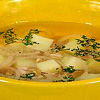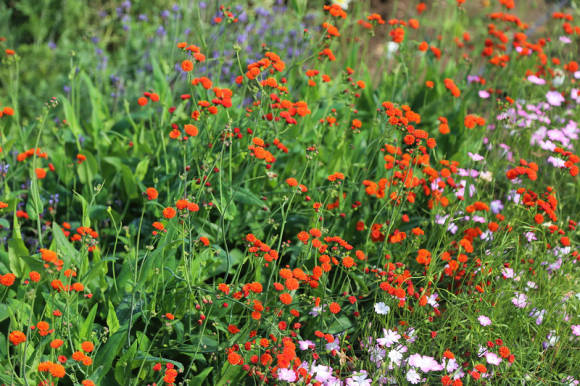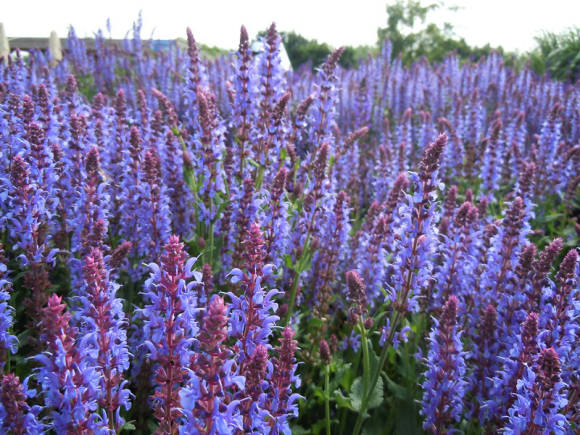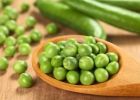 At the beginning of summer, the vegetable garden is still poor for the harvest. Ridge cucumbers are just beginning to bloom, the first zucchini are tied, bunch carrots are poured, salad and spicy herbs cannot provide a full-fledged vegetable set. It is possible to diversify the assortment of garden crops at this time with the help of cabbage. In addition to the traditional white cabbage early varieties, cauliflower, broccoli, kohlrabi, Chinese cabbage, Chinese cabbage and Japanese cabbage can provide vitamin and healthy products for the June table.
At the beginning of summer, the vegetable garden is still poor for the harvest. Ridge cucumbers are just beginning to bloom, the first zucchini are tied, bunch carrots are poured, salad and spicy herbs cannot provide a full-fledged vegetable set. It is possible to diversify the assortment of garden crops at this time with the help of cabbage. In addition to the traditional white cabbage early varieties, cauliflower, broccoli, kohlrabi, Chinese cabbage, Chinese cabbage and Japanese cabbage can provide vitamin and healthy products for the June table. Kohlrabi is perhaps the fastest ripening and undemanding to growing conditions of all the crops listed. Seedlings are ready for planting in the ground 10-15 days earlier than white, after 30-35 days. Kohlrabi eat a thickened stem plant that looks like a turnip in appearance, but the pulp is more tender and juicy. When sowing at the end of March, it can be planted in early May, and start harvesting at the beginning of June.
Starting in May, seeds are sown directly into open ground - in a non-seedling way according to a 60x30 cm scheme. Kohlrabi can be successfully used as a compactor, planting later crops, for example, Brussels sprouts or white cabbage, in the aisles. The main thing in growing kohlrabi, however, like many other crops of the cabbage family, is abundant and regular watering. With a lack of moisture, the pulp of the stems becomes coarse and fibrous, a characteristic mustard flavor appears.
Kohlrabi is the champion among other cabbages in terms of vitamin C content, it is rightfully called the "northern lemon", in addition, it is rich in vitamin PP and sucrose. The most popular varieties Vienna White 1350, Gigant, Violeta, F1 Korist, F1 Hummingbird. Early ripening varieties have a light green color of the stem-grower, later ones are purple.

Broccoli, or asparagus, is becoming increasingly popular among vegetable growers. Its green heads, similar to small cauliflower inflorescences, are a storehouse of live multivitamins (A, B1, B2, PP, C, K, potassium, phosphorus, calcium and magnesium salts). Broccoli sprouts are rich in carotene and sugars, and are superior in protein content to asparagus, spinach and corn. The protein contains anti-sclerotic substances (methionine and choline) that prevent the accumulation of cholesterol in the body, which makes this cabbage an indispensable component of various diets. In addition, broccoli heads are a valuable source of iodine.
It is not difficult to grow this cabbage. For normal growth, she needs good lighting and moderate watering. Seeds are sown in early April directly into the ground, seedlings are planted in early May in order to start harvesting at the end of June. After cutting off the central head, new, but smaller ones, develop in the leaf axils. Thus, harvesting continues until frost. Delicate heads are not stored for a long time, so they must be used immediately for food.
Early and late broccoli varieties differ in inflorescence formation. Early ripening varieties Vitaminnaya, Tonus, F1 Corvette form a medium-sized, loose central head and at the same time - lateral ones in the leaf axils, and late-ripening F1 Varnishes, F1 Aurora, F1 Linda, F1 Fiesta initially form a larger and denser central head, while lateral offspring heads appear after cut off the central.
White cabbage may seem less interesting compared to other varieties, but its role in healthy eating is undeniable. White cabbage contains all known vitamins, vitamin C in its leaves is ten times more than in carrots, and five times more than in onions, garlic and beets. But white cabbage is of particular value as a source of "antiulcer" vitamin U. In addition, vegetable proteins are highly digestible. |  |
At the beginning of growth, it is necessary to protect the plantings from the cruciferous flea, which, ulcerating the young leaves, greatly weakens the fragile plant. In the future, the heads of cabbage need to be protected from the caterpillars of the cabbage whites, gnawing at the leaves. You can fight pests with insecticides, but it is easier and safer to cover plantings with spunbond, which, moreover, allows you to retain moisture in hot weather.
Harvesting begins in mid-June selectively, avoiding cracking. After cutting the head of cabbage, the plants can be fed and left to grow further. In the fall, several new heads of cabbage are formed on each "stump". Thus, the early ripening varieties manage to get two harvests per year. Promising varieties: June 3200, Number one Gribovsky 147, F1 Solo, F1 Surprise, F1 Parel, F1 Express.
 |  |
Of all types, cauliflower is the most delicious, but also the most capricious. It is not easy to grow it, it is very demanding on soil fertility. In addition to the main elements nitrogen, phosphorus and potassium, microelements are necessary for the formation of the head: boron, molybdenum, copper, manganese, etc. Feeding with microelements in the phase of 4-5 and 12-15 leaves is especially effective.
 |  |
Cauliflower reacts strongly to soil acidity, optimal for its cultivation are soils with a pH of about 6. It is also demanding to the air temperature, for successful cultivation, a temperature of 15-17 ° C is required, when the temperature rises to 25 ° C, the heads are formed small, loose and bitter in taste. Lack of light, especially during the seedling season, also affects the quality of the crop. In the future, it is also necessary to avoid thickened plantings, do not plant plants in the shade of buildings and trees, in such conditions the heads may not form at all.
 |  |  |
You can grow cauliflower using the conveyor method, planting seedlings several times per season, starting in April, avoiding planting in the hottest period. The earliest ripening varieties of cauliflower: MOVIR 74, Guarantee, Early Gribovskaya 1355, F1 Alpha, F1 Malimba, Snowball, Pioneer, Goodman, F1 Stargate. In recent years, varieties with colored heads have appeared: yellow, greenish and even purple. They are original, but inferior in taste to white-colored varieties, the heads are slightly bitter and coarser. Cauliflower with an original cone-shaped head is green in color. F1 Amphora and F1 Veronica (Romanesco type) heads retain their original color and hardly soften during cooking, which makes them ideal for freezing.
Peking cabbage not only tastes great, but also has a high nutritional value. The leaves contain many vitamins, including up to 50 mg% ascorbic acid. It is believed to have dietary and medicinal properties, useful in heart disease and peptic ulcer disease.There are several forms of Peking cabbage: collard, half-cabbage and cabbage. Peking cabbage ripens, depending on the variety and growing conditions, in 20-50 days, so it can be grown through seedlings or by direct sowing into the ground as a seal or catch crop. When growing seedlings, temperatures above 15-18 ° C should not be allowed, otherwise it may go into the stem. The earliest ripening varieties: Lenok, F1 Manoko, F1 Nika, F1 Mirako.
 |  |
Chinese cabbage differs from Peking cabbage in the absence of pubescence on the leaves and the presence of a wide and juicy petiole. Chinese cabbage ripens in just 40-50 days from the moment of sowing, but you can use it earlier - in fact, with the formation of the first true leaves.
Chinese cabbage is grown both through seedlings (optimally 20 days old), as well as by direct sowing in the ground in late April - early May. The planting pattern of seedlings is 50x30 cm. In terms of mineral composition, Chinese cabbage stands out among other varieties with a high content of calcium, phosphorus and iron. The most famous varieties: Swallow, Vesnyanka, Alyonushka.
 |  |
One of the least known forms is Japanese cabbage. It was originally considered a variety of Chinese cabbage, but later it was singled out as a separate species. This is an ultra-early ripening, unpretentious salad vegetable that can be used as an ornamental one.










